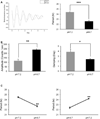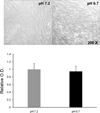Extracellular low pH affects circadian rhythm expression in human primary fibroblasts
- PMID: 22115778
- PMCID: PMC3243307
- DOI: 10.1016/j.bbrc.2011.11.037
Extracellular low pH affects circadian rhythm expression in human primary fibroblasts
Abstract
Circadian rhythm is a fundamental biological system involved in the regulation of various physiological functions. However, little is known about a nature or function of circadian clock in human primary cells. In the present study, we have applied in vitro real time circadian rhythm monitoring to study human clock properties using primary skin fibroblasts. Among factors that affect human physiology, slightly lower extracellular pH was chosen to test its effects on circadian rhythm expression. We established human primary fibroblast cultures obtained from three healthy subjects, stably delivered a circadian reporter gene Bmal1-luciferase, and recorded circadian rhythms in the culture medium at pH 7.2 and 6.7. At pH 7.2, robust and sustained circadian rhythms were observed with average period length 24.47 ± 0.03 h. Such rhythms were also found at pH 6.7; however, period length was significantly shortened to 22.60 ± 0.20, amplitude was increased, and damping rate was decreased. The effect of exposure to low pH on the period length was reversible. The shortened period was unlikely caused by factors affecting cell viability because cell morphology and MTT assay showed no significant difference between the two conditions. In summary, our results showed that the circadian rhythm expression is affected at pH 6.7 in human primary fibroblasts without affecting cell viability.
Copyright © 2011 Elsevier Inc. All rights reserved.
Figures


Similar articles
-
Assessment of circadian rhythms in humans: comparison of real-time fibroblast reporter imaging with plasma melatonin.FASEB J. 2012 Jun;26(6):2414-23. doi: 10.1096/fj.11-201699. Epub 2012 Feb 27. FASEB J. 2012. PMID: 22371527 Free PMC article.
-
Fibroblast PER2 circadian rhythmicity depends on cell density.J Biol Rhythms. 2013 Jun;28(3):183-92. doi: 10.1177/0748730413487494. J Biol Rhythms. 2013. PMID: 23735497 Free PMC article.
-
O-GlcNAcylation of BMAL1 regulates circadian rhythms in NIH3T3 fibroblasts.Biochem Biophys Res Commun. 2013 Feb 15;431(3):382-7. doi: 10.1016/j.bbrc.2013.01.043. Epub 2013 Jan 18. Biochem Biophys Res Commun. 2013. PMID: 23337503
-
Altered rhythm of adrenal clock genes, StAR and serum corticosterone in VIP receptor 2-deficient mice.J Mol Neurosci. 2012 Nov;48(3):584-96. doi: 10.1007/s12031-012-9804-7. Epub 2012 May 24. J Mol Neurosci. 2012. PMID: 22622901
-
[The roles of clock genes in obesity].Nihon Rinsho. 2013 Feb;71(2):244-8. Nihon Rinsho. 2013. PMID: 23631200 Review. Japanese.
Cited by
-
Assessment of circadian rhythms in humans: comparison of real-time fibroblast reporter imaging with plasma melatonin.FASEB J. 2012 Jun;26(6):2414-23. doi: 10.1096/fj.11-201699. Epub 2012 Feb 27. FASEB J. 2012. PMID: 22371527 Free PMC article.
-
Circadian adaptation to cell injury stresses: a crucial interplay of BMAL1 and HSF1.J Physiol Sci. 2016 Jul;66(4):303-6. doi: 10.1007/s12576-016-0436-5. Epub 2016 Feb 24. J Physiol Sci. 2016. PMID: 26910317 Free PMC article. Review.
-
Maternal eating behavior is a major synchronizer of fetal and postnatal peripheral clocks in mice.Cell Mol Life Sci. 2018 Nov;75(21):3991-4005. doi: 10.1007/s00018-018-2845-5. Epub 2018 May 26. Cell Mol Life Sci. 2018. PMID: 29804258 Free PMC article.
-
A Method for Culturing Mouse Whisker Follicles to Study Circadian Rhythms ex vivo.Bio Protoc. 2019 Jan 20;9(2):e3148. doi: 10.21769/BioProtoc.3148. eCollection 2019 Jan 20. Bio Protoc. 2019. PMID: 33654893 Free PMC article.
-
12-h clock regulation of genetic information flow by XBP1s.PLoS Biol. 2020 Jan 14;18(1):e3000580. doi: 10.1371/journal.pbio.3000580. eCollection 2020 Jan. PLoS Biol. 2020. PMID: 31935211 Free PMC article.
References
Publication types
MeSH terms
Substances
Grants and funding
- R01 EY004864/EY/NEI NIH HHS/United States
- U54RR026137/RR/NCRR NIH HHS/United States
- U54 MD007588/MD/NIMHD NIH HHS/United States
- P30 EY006360/EY/NEI NIH HHS/United States
- G12 RR003034/RR/NCRR NIH HHS/United States
- P20 RR011104/RR/NCRR NIH HHS/United States
- NS060659/NS/NINDS NIH HHS/United States
- G12-RR03034/RR/NCRR NIH HHS/United States
- 5P20RR11104/RR/NCRR NIH HHS/United States
- U54 RR026137/RR/NCRR NIH HHS/United States
- S21 MD000101/MD/NIMHD NIH HHS/United States
- U54 NS060659/NS/NINDS NIH HHS/United States
- 21MD000101/MD/NIMHD NIH HHS/United States
LinkOut - more resources
Full Text Sources

